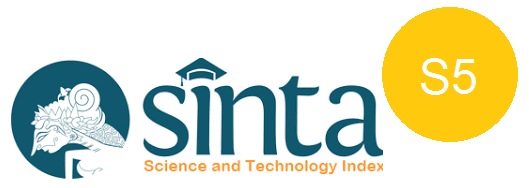Rhetorical Structure on Research Article Abstracts in Informatics and Computer Science Journals
DOI:
https://doi.org/10.47313/pujangga.v8i2.1969Keywords:
move structure, journal abstracts, genre-based approachAbstract
ABSTRACT
In order to attain coherence, research abstracts must contain a number of crucial steps, although these steps do not always follow the same sequence. Contexts tend to dictate different writing styles. This study looked at how the rhetorical structure or move structures were used, distributed, and arranged in 30 abstracts as incorporating of two Computer Science & Engineering, and Information Systems journals in Indonesia. Each move was classified and categorized using the five-move analysis paradigm developed by Hyland. Findings from the analysis showed that there were 12 organizational move pattern appears. Some had all the five moves, some had four moves and others only three. There were 15 abstracts that contained all the five moves identified with 9 abstracts following the framework M1-M2-M3-M4-M5, while the other 6 are random. 13 abstracts contained 4 moves with 10 following the M1-M2-M3-M4 pattern, while the other 3 are random. Another 2 abstracts only contained three moves with M1-M2-M3 and M1-M2-in pattern. In conclusion, this present study showed that the 50% of RA abstracts of the two journals have fulfilled the Hyland’s five model. Furthermore, in order to assist the student researchers in creating well-written abstracts, it would be good to provide explicit training and experiential learning through a genre-based approach.
References
Berkenkotter, C., & Huckin, T. N. (1995). Genre knowledge in disciplinary communication: Cognition/culture/power. Lawrence Erlbaum Associates, Inc.
Bhatia, V.K. (2002) A generic view of academic discourse : In J. Flowerdew (Ed.), Academic Discourse (pp. 21-39). Harlow: Longman.
Doyle et al. (2020). An overview of the qualitative descriptive design within nursing research. Journal of Research in Nursing. Vol. 25(5): 443–455. doi: 10.1177/1744987119880234. https://www.ncbi.nlm.nih.gov/pmc/articles/PMC7932381/
Huckin, T. (2001). Abstracting from Abstracts. In M. Hewings (Ed.), Academic Writing in Context: Implications and Applications (pp. 93-103). Birmingham: The University of Birmingham Press.
Hyland, K. &Salager-Meyer, F. (2008). Science writing. In Cronin, B. (ed) Annual Review of Information Science and Technology. Vol 42: 297-338
Hyland, K. (2000). Disciplinary Discourse: Social interaction in academy writing. London, UK: Longman.
Hyland, K. (2009). Academic Discourse: English in a global context. London: Continuum.
Lambert V. & Lambert C. (2012) Qualitative Descriptive Research: An Acceptable Design. Pacific Rim International Journal of Nursing Research [Internet], 16(4):255-6. Available from: https://www.tcithaijo.org/index.php/PRIJNR/article/view/5805
Lores, R. (2004). On RA Abstracts : From rhetorical structure to thematic organization. English for Specific Purposes, 23(3), 280-302. http://dx.doi.org/10.1016/j.esp.2003.06.001
Martin, P.M. (2001). A genre analysis of English and Spanish research paper abstracts in experimental social sciences. English for English Purposes, 23. 25-43. 2001
Nassaji, H. 2015. Language Teaching Research: Qualitative and Descriptive Reserach: Data Type versus Data Analysis Vol. 19(2) 129–132. sagepub.co.uk/journalsPermissions.nav DOI: 10.1177/1362168815572747 ltr.sagepub.com
Parodi, G. (2014). Genre organization in specialized discourse: Disciplinary variation across university textbooks. Vol. 16, No. 1 (February 2014), pp. 65-87. Sage Publication, Inc. https://www.jstor.org/stable/24441978
Pho, P. (2008). Research article abstracts in applied linguistics and educational technologgy : a study of linguistic realizations of rhetorical structure and authorial stance. Discourse Studies, 10(2), 231- 250. 2008. http://dx.doi.org/10.1016/j.esp2003.06.001
Samraj, B. (2002). Disciplinary variation in abstracts: The case of wildlife behavior and conservation biology. In J. Flowerdew (Ed.), Academic Discourse (pp. 20-56). Harlow : Longman.2002.
Santos, M.B.D. (1996). The textual organization of research paper abstracts in applied linguistic. Text, 16(4), 481-499.
Swales, J.M. (1990). Genre Analysis: English in academic and research setting. Cambridge, UK: Cambridge University Press.
Swales, J.M. (2004). Research Genres: Explorations and Applications. Cambridge, UK: Cambridge University Press.
Tocalo A.W.I. (2021). Move structures and their rhetorical verbs of research article abstracts across Englishes. Indonesian Journal of Applied Linguistics. Vol. 11 No. 1, pp. 1-10 Available online at: https://ejournal.upi.edu/index.php/IJAL/article/view/34593. https://doi.org/10.17509/ijal.v11i1.3459
Tseng, F.p. (2011). Analyses of move structure and verb tense of research article abstracts in applied linguistic journals. International Journal of English Linguistics, 1(2), 27-39. H
Viera, R.T. (2019). Rhetorical Move Structure in Abstracts of Research Articles Published in Ecuadorian and American English-Speaking Context. Arab World English Journal (AWEJ) Volume 10. Number 4, Pp.74 -87 DOI: https://dx.doi.org/10.24093/awej/vol10no4.6








